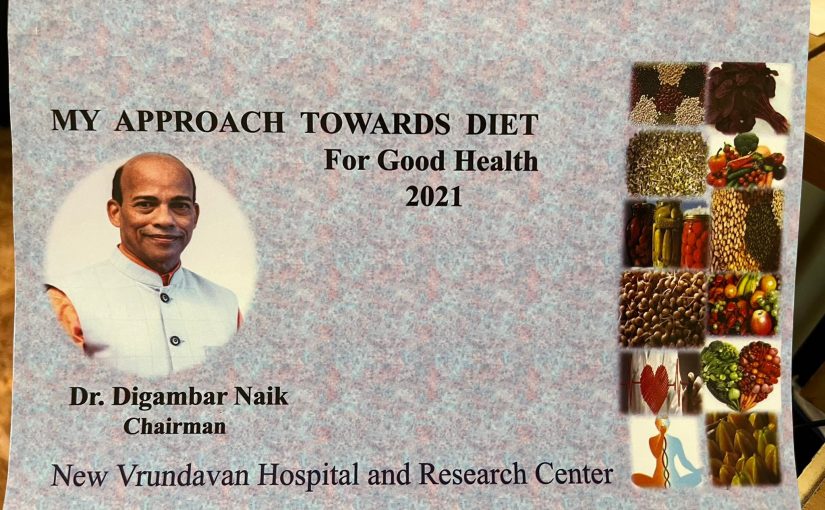Some rudimantory tips on how to change one’s bad eating habits… A booklet given to patients by Dr Digambar Naik
DR DIGAMBAR Naik of the New Vrundavan Hospital & Research Center goes that extra mile for his patients! He has come out with a small booklet which he gives all his patients – titled “My Approach Towards Diet, For Good Health.” This booklet is full of information we need to know even if some of it we may already know, but are doing nothing about for reasons best known to us. Never complain then if various parts of your body beautiful continue to degenerate for want of some discipline and the right tender loving care (the body is the temple of our mind and body, heart and soul)!
Anyway in this easy booklet Dr Digambar lays down some good advice we ought to follow more and more if we want to live happy till a century at least…first of all he says we are exactly “What you eat, what you exercise, what you think.” Be wise! He quotes the late Lambert Mascarenhas who lived to a happy 107 years and when asked, the author of “Sorrowing Lies My Land” would say: “Discipline is eating is important. I never ate extra even in a party. Less food is better than more. Fasting one day a week made me more healthy. All good foods in moderation are good. It is terrible to develop a paunch. All my friends who had a paunch have died already. I am a non-vegetarian.”
How much food should I eat? The question arises and Dr Digambar says “Usually in a debilitating sickness the number of calories required are more.”
According to him the best way to eat is to: Avoid all processed foods. Buy organic ingredients for your cooking as much as you can, ingredients from healthy nourishing earth which has not been manipulated with chemical fertilizers or the seeds genetically modified to fit some businessman’s profit margins.
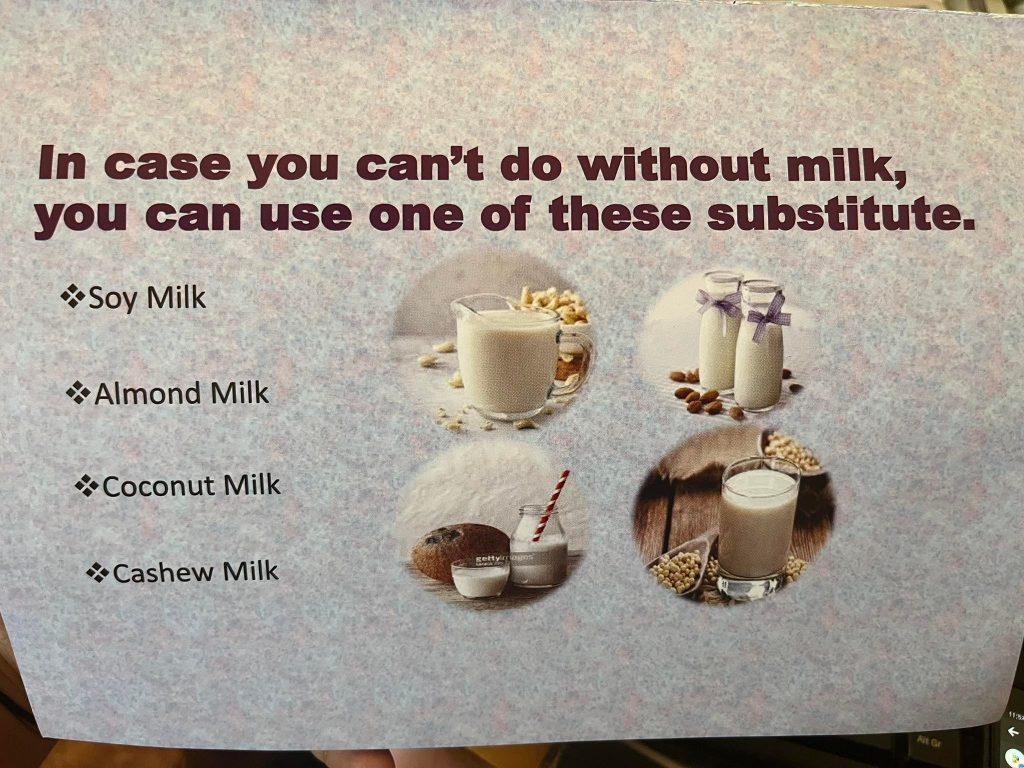
Our food should be nutritious – be it carbohydrates, proteins, fats, vitamins and minerals, antioxidants, phytochemicals, enzymes which we get only if we eat freshly harvested greens and fruits in salad recipes not drowned in salty or sugary or oily dressings! Pour carbohydrates come from mainly from rice, wheat, jawar, bajra, oats, millets, quinoa and other grains. Also sweets, desserts, chocolates, ice-cream, caramel, jalebies, etc; processed carbs are ready made food like biscuits, cookies. When it comes to consuming carbs be they refined or wholegrain know something about what the glycaemic index of your food is: How quickly will a food raise the sugar level in blood? Lesser the glycaemic index, better is the food in keeping your pancreas safe and healthy. Overconsumption of carbohydrates take a toll of the pancreas which manufactures the insulin required to get glucose into each cell of your body for energy production. Eat about 30% proteins, 40% carbohydrates, 30% fats.
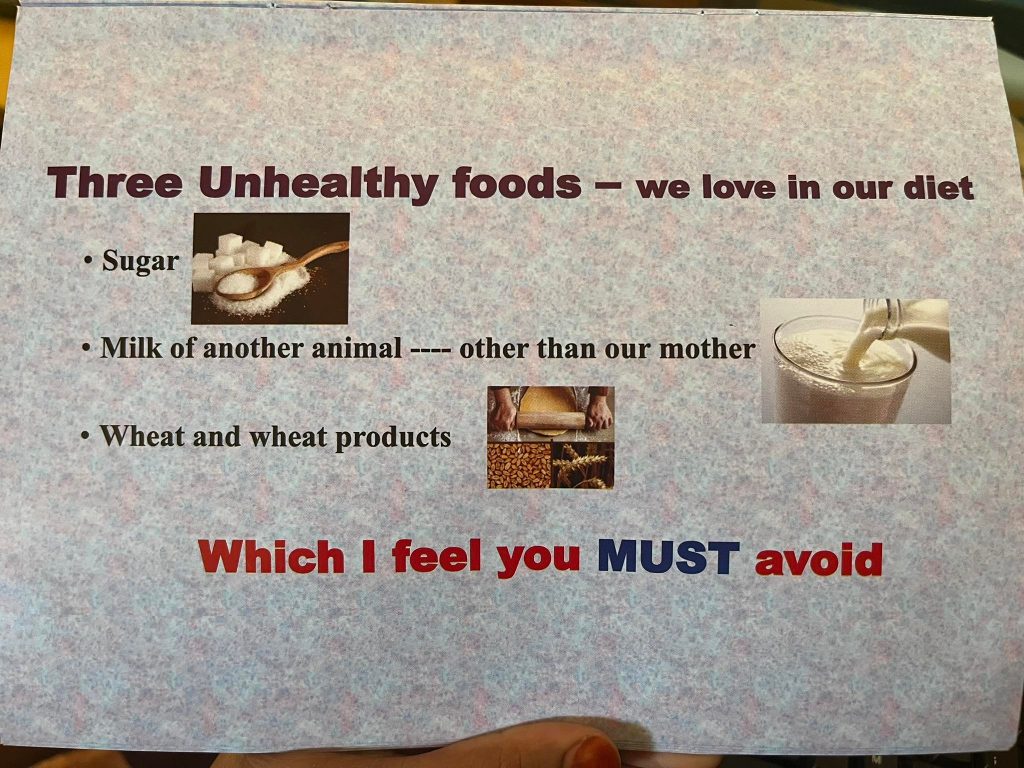
Foods rich in animal proteins are fish, eggs, chicken, mutton. Vegetable proteins are pulses, dal, seeds, nuts, beans, legumes, soya product tofu. Then be careful about the fats you eat because there are good fats and bad fats. Good fats are to be found in some oils, nuts, fish, seeds, eggs, dark chocolates, avocados, ghee, cheese, virgin oils, fish oils. The bad fats are usually in meat, poultry, dairy, fried food, biscuits, cookies, refined oils, junk food, ice-cream, etc. Learn something about saturated and unsaturated (MUFA/PUFA) fats, you need them in equal quantity.
Vitamins/minerals/antioxidants/phytochemicals are to be found in all fruit, avocado, vegetables, nuts – almonds, walnuts, hazelnuts, pistachio, cashew, dry fruit, dates, raisins, figs, seeds like flax seeds, sesame seeds, pumpkin seeds and spices. Some of all these from natural sources should be eaten daily.
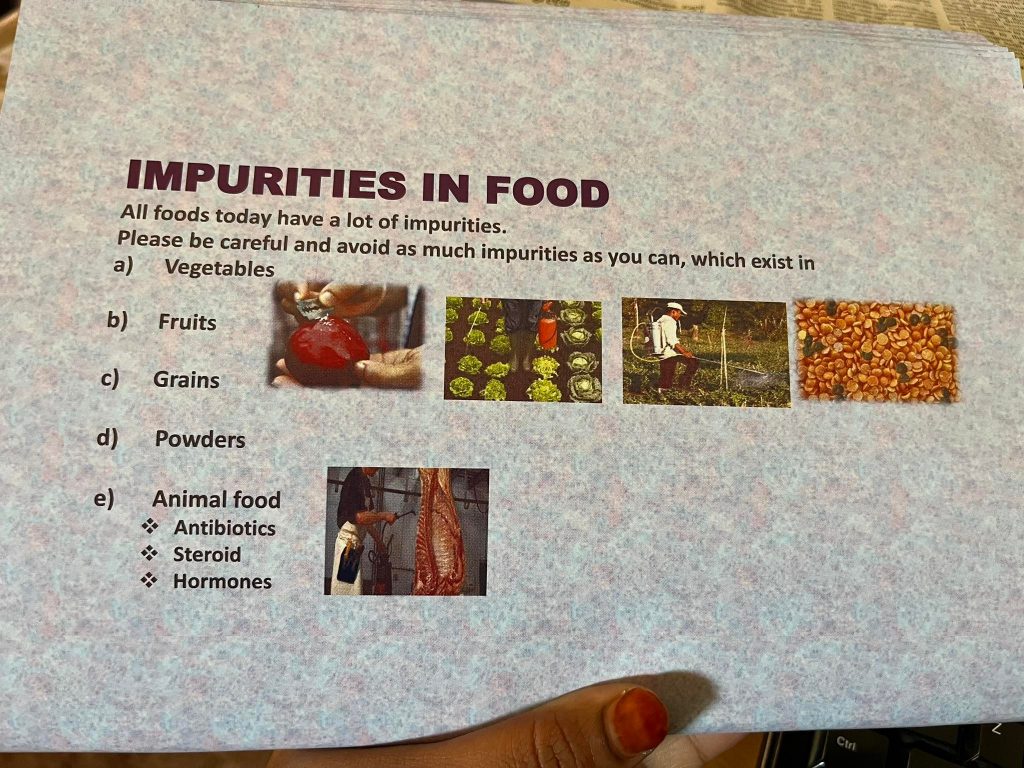
SO MANY DIETS!
How familiar with all the diets being prescribed by various experts? Find out about the…
- Hay Combinations diet
- Mediterranean Diet
- South Beach Diet
- The Paleo Diet
- Low Carb Diet
- Low Fat Diet
- Dean Ornish Diet
- Atkins Diet
- Vegan Diet
- Dixit Diet
*Dash Diet…and many more!
(I would add the keto diet as the latest diet in which people are taking an interest in.)
Remember that no person in the world can be happy and healthy following la fixed diet. We need to eat and enjoy a variety of food with variety of tastes, colours and nutritional values.
Dr Digambar illustrates that our traditional breakfast diet of bhaji, chapatti, bread, coffee and tea does not meet nutritional requirements. We need to change quickly!
For a start he says, Start with curds on empty stomach. Have at least three different coloured fruit and three vegetables every week, non-vegetarian is not bad food, have fish and chicken/mutton in small quantity; above all, have a nice, tasty, stimulating meal.
A traditional lunch of rice, fish curry does not make for a nutritional meal either. Eat chicken and mutton in small quantity; avoid fried and deep-fried food; take sufficient salt but don’t overdo it (depending on the salt level in blood); tea, coffee, nuts, dry fruit, seeds, if required.
A vegetarian lunch should be fruit, rice, curds, pickles, dal/pulses/legumes, vegetables.
Dinner too should be varied but be aware of quality and quantity. (Do not make dinner you main meal of the day especially if you have been breakfasting and lunching like a rich man!
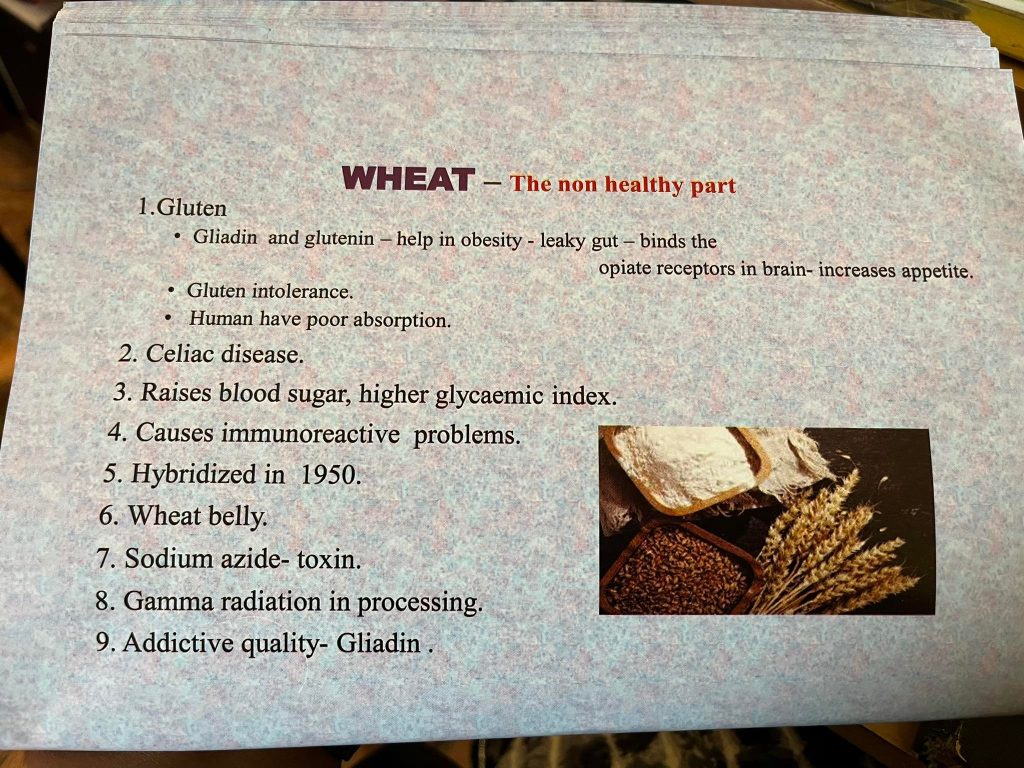
ALL THIS AND MUCH MORE
Special aspects of food are eating together; eating slowly; do not eat in front of TV; no snacking in between meals; eat with senior members of the family; cooking should be consciously done and in a happy mood; have fun in kitchen; god of satiety is in the kitchen so say Tathastu whenever you can. Finally, be creative in serving: Color, aroma, taste, presentation. Eating must be a stimulating affair of life and living.
YES, there are three unhealthy foods we love in our common diet!
These are sugar, milk of other animals, wheat and wheat products. Dr Digambar says these are three foods we must avoid. Why?
WHEAT
There is gluten. Gliadin and glutenin help obesity, leaky gut, binds the opiate receptors in brain, increases appetite.
Most of us are gluten intolerant. Humans have poor absorption of gluten.
Wheat products are responsible for celiac disease, raise blood sugar, have a higher glycaemic index; cause immunoreactive problems; wheat was hybridized in 1950…leads to wheat belly, sodium azide is a toxin, gamma radiation in processing is bad, wheat gliadin has an addictive quality.
Also, wheat eating means lectins which bind to insulin receptors and intestinal lining, increases inflammation, leads to autoimmune disease and insulin resistance, metabolic syndrome.
Phytic acid in wheat cannot be digested by humans, it binds to calcium, magnesium, zinc, iron , reducing absorption, causes anaemia and osteoporosis.
Wheat fibre is a myth. Amlopectin in it leads to obesity, craving.
(BOTTOMLINE: Avoid wheat in any form and see the change for the better in six months. Exchange wheat ingredients for millet ingredients!)
MILK
THERE are so many reasons why we should not drink the milk of another animal so passionately!
• Is there any animal in the world drinking milk from another animal mother? The constitution of a cow or other milk animals differs from human milk. So also the human gastrointestinal tract which is different from that of a bovine animal. The functionality and the pH at various parts of the bovine gut is different from that of the human gut. There are digestive and immunological differences between the two. Today we know clearly that our gut has full influence on our brains and the whole immune and endocrine systems.
• The antibodies, allergens and pathogens in bovine and human milk differ. Obviously, the immunological reactions will be different.
• This will create a chronic inflammation in our systems which impact every organ in the body. Today we know that inflammation is the basic pathology in most diseases.
• Studies have found there are more fractures and osteopenia problems in people having more than two glasses of milk every day.
• And infant has poorly developed gut, when it is born. Human milk has different growth factors that facilitate gut maturation. Gut maturation and TJ (tight junctions) maturation in infants fed on milk formula is poor. This leads to leaky gut syndrome which is the cause of autoimmune disease and degenerative diseases.
• Since the milk components of human and bovine milk are different obviously they will different impact on respiratory tract, microbiota and immune trafficking.
• Incidence of acne, eczema, allergies, colic, constipation, diarrhoea, bloating, lactose intolerance are higher in people consuming dairy milk.
• Studies show higher incidence of prostate, ovarian and other cancers in people consuming more than two glasses of milk daily.
• Cow’s or bovine stomach consists of four parts and functionally it is different compared to human stomach. A calf on cow’s milk gain hundreds of kg weight in a few months compared to human baby. This itself is enough to understand the calorific value of cow’s milk.
• No animal feeds it young after the weaning is over. How can nature allow the milk to a human adult and that too from another animal.
• IGF (insulin like growth factor), lactase and casein, the three ingredients are not good for humans. It can cause cancers like breast cancer, ovarian, prostate and colon cancers.
• 75% of world population have no lactase enzyme after one or two years of life and cannot digest lactose.
• Casein in milk is responsible for a number of cancers.
• Cow’s milk is perfect nutrition for the calf but not for human beings.
These are just pertinent excerpts selected from Dr Digambar Naik’s useful booklet “My Approach Towards Diet For Godo Health, 2021.” I hope you will think about the facts presented here and try to remove the ingredients in your eating habits which are actually down into the nightmare and hell of ill-health! Try avoiding them and see if you’re better off without dairy milk and its products, wheat and its products, bad fats and their products, refined industrial sugar and its products and the bad fats and preservative chemicals you find in processed foods which are not foods at all although you may be in love with them!
‘
